Abstract
Living through a pandemic and social upheaval suggests the importance of revisiting the intersections of the art and activism of Felix Gonzalez-Torres and Gregg Bordowitz. These artists’ works express their experiences of living through a pandemic and subsequent social change and draw out key human rights themes. The works’ materials, poetics, and invitations to interact offer opportunities for audiences to reflect on complex and ethically relevant social and cultural dynamics that surface during global crises, such as negotiating personal and collective interests, the politics of touch and coexistence, and cultivating resilience and strength.
Pandemics Through Art
Today, when thinking about pandemics, we consider global health crises caused by COVID-19 and the subsequent social upheaval that has elevated voices of black people across the United States and the globe. Memory and history remind us of other national and international pandemics and social crises. COVID-19 recalls the Spanish flu pandemic of 1918, and activism still draws on the energy of the civil rights movements of the 1950s and 1960s. Historical moments from the 1980s and early 1990s HIV/AIDS crisis combine fights against disease and fights for health care and human rights. When threats of ill health and social injustice collide, the right to live demands that we ask fundamental ethics questions.
Gregg Bordowitz and Felix Gonzalez-Torres’ work and histories give us space in which we can recognize the activism and poetry with which artists responded (and are still responding) to health and social crises that create moments of collective urgency, uncertainty, and resilience. Bordowitz shares his experience of the HIV/AIDS crisis: “So total was the burden of illness—mine and others’—that the only viable response, other than to cease making art entirely, was to adjust to the gravity of the predicament by using the crisis as a lens.”1 Today, again, we might consider these words and think about ways in which the COVID-19 pandemic crisis offers a lens through which we can learn from these artists and how their work can help orient us to our individual and collective pasts, presents, and futures.
Representing Incongruence and Inequality
The work of Gonzalez-Torres and Bordowitz, both activists in the HIV/AIDS crisis and both HIV positive, embodies complex ethical implications of pandemics that uncover political incongruencies, amplify social inequalities, and reveal sources of personal and community suffering.
Figure 1. Drive, 2002-2019, by Gregg Bordowitz. Installation view: Gregg Bordowitz: I Wanna Be Well. Art Institute of Chicago, April 4 to July 14, 2019, Chicago, Illinois. Image courtesy of the Art Institute of Chicago®.
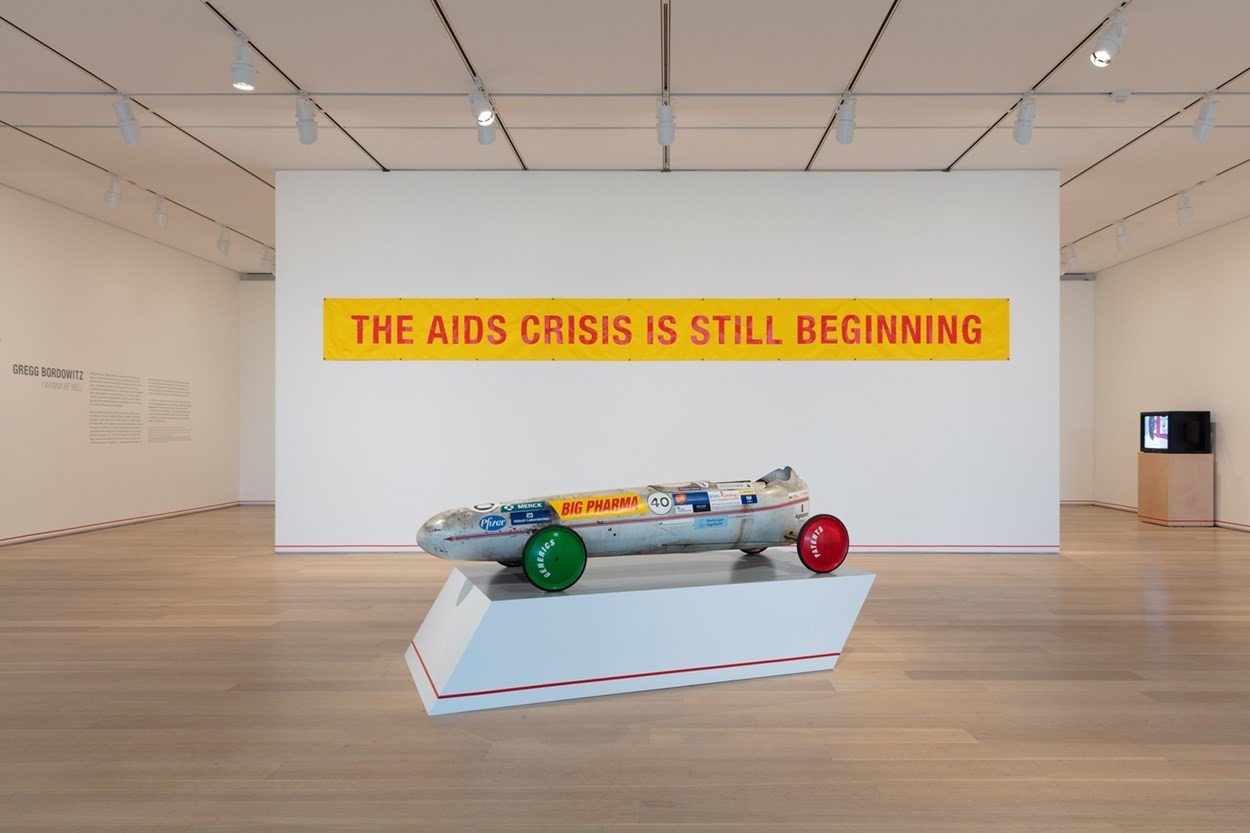
Used with permission of the artist.
Media
Vintage wheeled derby car with vinyl stickers on artist-designed plinth, vinyl banner, clocks, and 2 framed exhibition posters.
Gonzalez-Torres’ work carries conceptual significance in its intent for the work to hold multiple meanings. For instance, “Untitled” (Portrait of Ross in LA), can be interpreted through the politics of touch during the HIV/AIDS crisis. The pile of candy can be interpreted as representing the artist’s partner, Ross Laycock, who passed away in 1991 from health complications related to AIDS. Visitors in the museum gallery are given the choice to grab a candy, take it with them, maybe eat it if they decide to do so. They can also decide to enjoy the artwork simply by looking at it. Having the opportunity to interact with the work is an essential part of the experience. The candy pile (ideally weighting 175 pounds, the average weight of a healthy individual) thus can “lose weight,” just as the artist’s partner (and many other victims of AIDS) lost weight due to the illness and its treatment. Nonetheless, it is important to note that during any given manifestation of any candy work by Gonzalez-Torres, the owner or authorized borrower can make decisions regarding the work’s form and weight, so while the work can “lose weight,” it also has the potential to be replenished throughout the course of the exhibition depending on the borrower’s decisions. The flexible nature of the dimensions of the work is an essential part of it. The piece uncovers tensions in the museum space in which people are welcomed to touch (and take) the artwork, although visitors in a museum space are more typically surveilled and prohibited from touching at all. The COVID-19 pandemic and antiracism protests expose and elevate similar tensions: the threat of touching what can be infectious coexists with our urgent need to come together.
Figure 2. “Untitled” (Portrait of Ross in LA), 1991, by Felix Gonzalez-Torres. Installation view: Objects of Wonder: From Pedestal to Interaction. ARoS Aarhus Kunstmuseum, Aarhus, Denmark, October 12, 2019 to March 1, 2020. Curator: Pernille Taagard Dinesen. Photographer: Lise Balsby. Image courtesy of ARoS Aarhus Kunstmuseum.
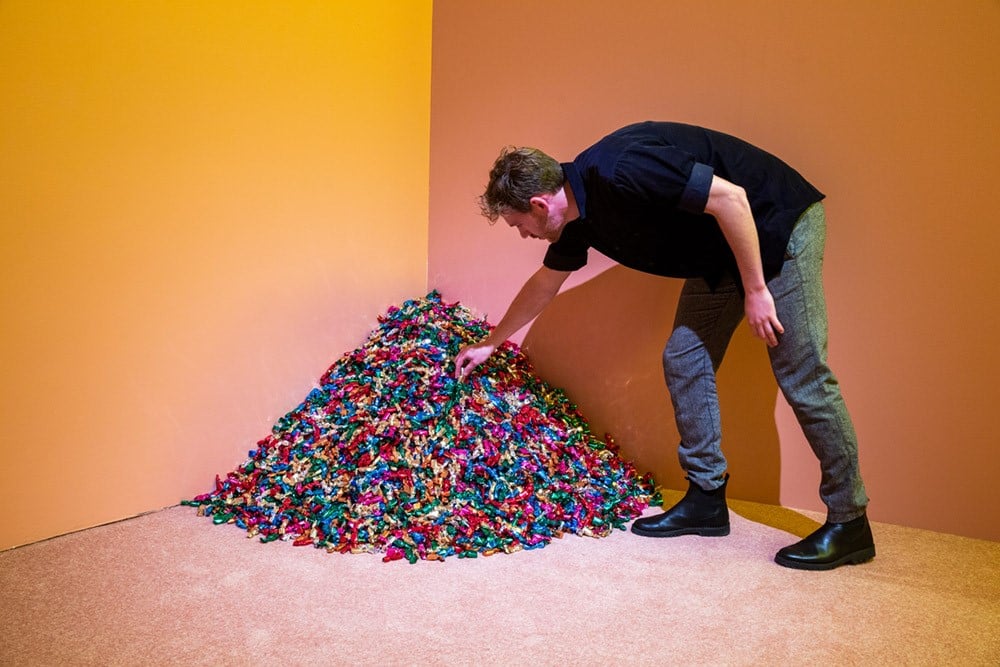
© Felix Gonzalez-Torres. Courtesy of the Felix Gonzalez-Torres Foundation.
Media
Candies in variously colored wrappers, endless supply. Overall dimensions vary with installation. Ideal weight: 175 lb.
The pile of candy, slowly dissipating or growing back again, also suggests a visual image of our public health need to “flatten the curve” (a graphic representation of day-to-day statistics) during the early part of the 2020 COVID-19 pandemic in the United States. Sheila Jasanoff, a professor of science and technology studies at Harvard University, argues that the animation and visualization with which pandemic data can now be represented is something that was indeed not possible during the HIV/AIDS crisis.2 Abstract graphic public health data contrasts with the concrete materiality of the Gonzalez-Torres installation and suggests key ethical questions arising from the relationships between individual life and collective existence during a global breakdown: When is a life worth saving? When do we declare further measures not worth doing?2
Artistic Activism
HIV/AIDS activists set a historical precedent in successfully demanding that policymakers address the crisis.2 The AIDS pandemic was ignored for years, unnamed by politicians and neglected by mainstream society. From 1987 to 1991, Gonzalez-Torres belonged to Group Material, a collective in New York’s East Village whose members were on a mission during the 1980s and early 1990s “to call attention to the unethical and despicable behavior of mainstream society, in response to the AIDS crisis.”3 But it wasn’t until the mid-1980s, when the demographics of AIDS patients diversified to include users of intravenous drugs and blood products, that governments decided to take action.3 AIDS activism brought about extraordinary gains, such as drug approvals, increased research budgets, and more targeted science, until 1996 when the US government approved powerful new antiretroviral drugs.4 Today, again, authorities are called upon to revisit access to health care and to create policies that challenge structural racism at multiple levels of our realities. We have a long road ahead.
Today, again, authorities are called upon to revisit access to health care and to create policies that challenge structural racism at multiple levels.
Ongoing struggle for health and human rights was the topic of a virtual lecture that Bordowitz gave at the School of the Art Institute of Chicago just as the COVID-19 pandemic started to unfold in the United States in 2020. While discussing his artistic and activist work, he said: “I was doing it, I am still doing it, and my work is an example of how catastrophes get represented, normalized and not really resolved, how the spotlight moves on.”5 In his recent retrospective show, I Wanna Be Well,6 Bordowitz included a giant banner: “THE AIDS CRISIS IS STILL BEGINNING.” And, like the motto “Black Lives Matter,” this motto compels us to listen, pay attention, look back into history, learn from it, and, more importantly, take action.
Figure 3. The AIDS Crisis Is Still Beginning, 2019, by Gregg Bordowitz. Installation view: Gregg Bordowitz: I Wanna Be Well. Art Institute of Chicago, April 4 to July 14, 2019, Chicago, Illinois. Image courtesy of the Art Institute of Chicago®.
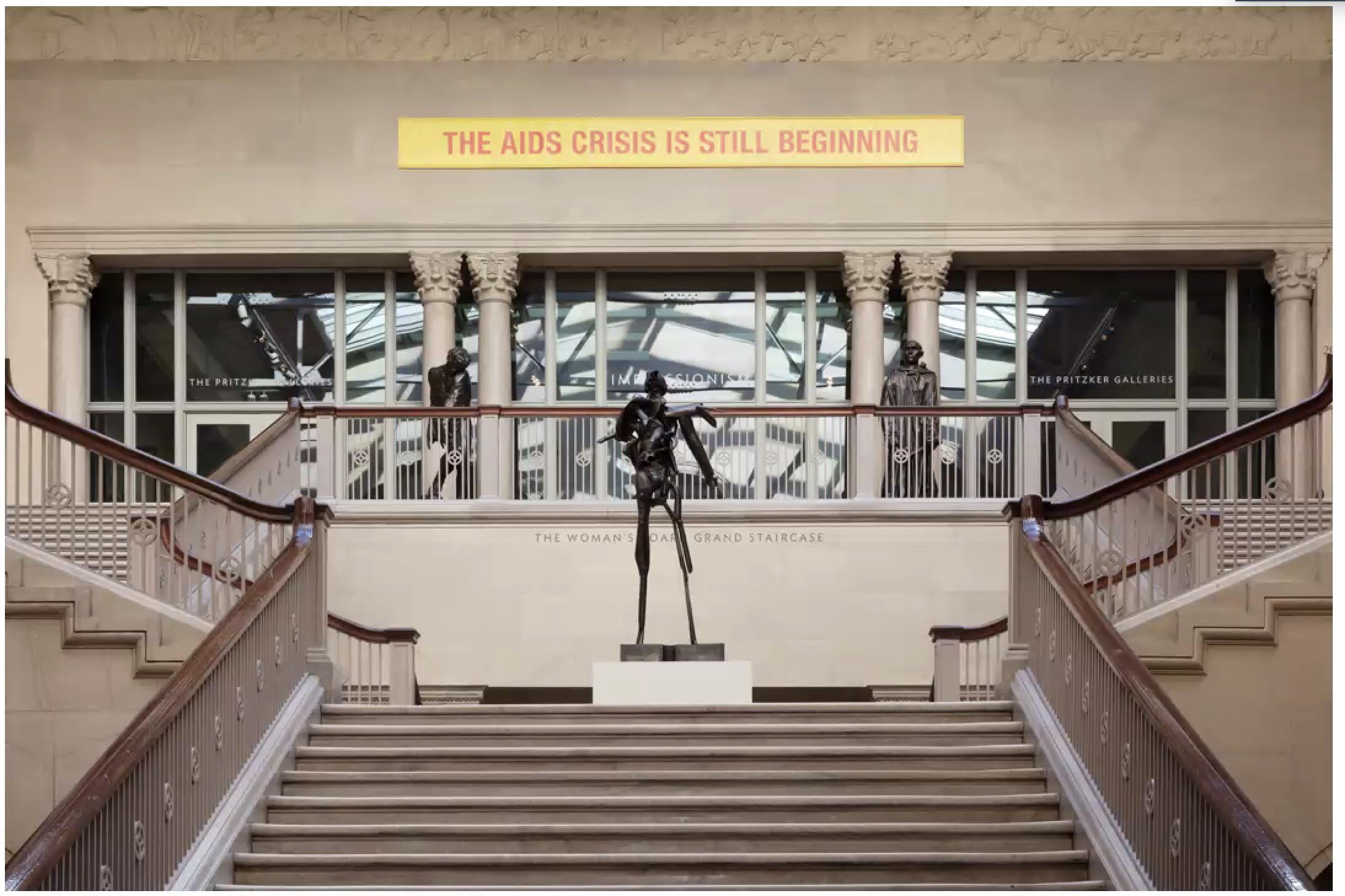
Used with permission of the artist.
Media
Vinyl banner.
In contrast to Gonzalez-Torres’ metaphorical and conceptual approach, Bordowitz’s work and poetics are explicitly activist in tone. Self-portraits that Bordowitz drew as he lost weight when he was first treated for HIV (see Figure 4) might, on one interpretation of “Untitled” (Portrait of Ross in LA), evoke the similar experience of Gonzalez-Torres’ partner.
Figure 4. Detail from Self-Portraits in Mirror, 1996, by Gregg Bordowitz. Installation view: Gregg Bordowitz: I Wanna Be Well. Art Institute of Chicago, April 4 to July 14, 2019, Chicago, Illinois. Image courtesy of the Art Institute of Chicago®.
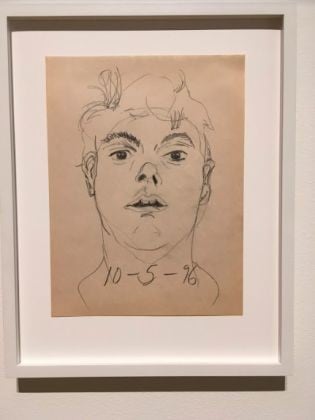
Used with permission of the artist.
Media
Graphite on paper.
Among many other works that represented his lifelong investigations of identity and illness7 is Bordowitz’s other self-portrait in the form of an installation view of his personal library (see Figure 5). A library is both intimate and public, an apt contrast, perhaps, for his personal struggle with illness, which can also inform broader community efforts to cultivate resilience and strength. In his lecture, Bordowitz stated that the “personal part is about plurality. It shouldn’t evolve into the singular. It should resonate and vibrate with shared experiences…. Art constitutes a great vitality of our lives.”7
Figure 5. Installation view of Debris Fields, 2014, and Selections From Gregg Bordowitz’s Library, 1983–2011, by Gregg Bordowitz. Installation view: Gregg Bordowitz: I Wanna Be Well. Art Institute of Chicago, April 4 to July 14, 2019, Chicago, Illinois. Image courtesy of the Art Institute of Chicago®.
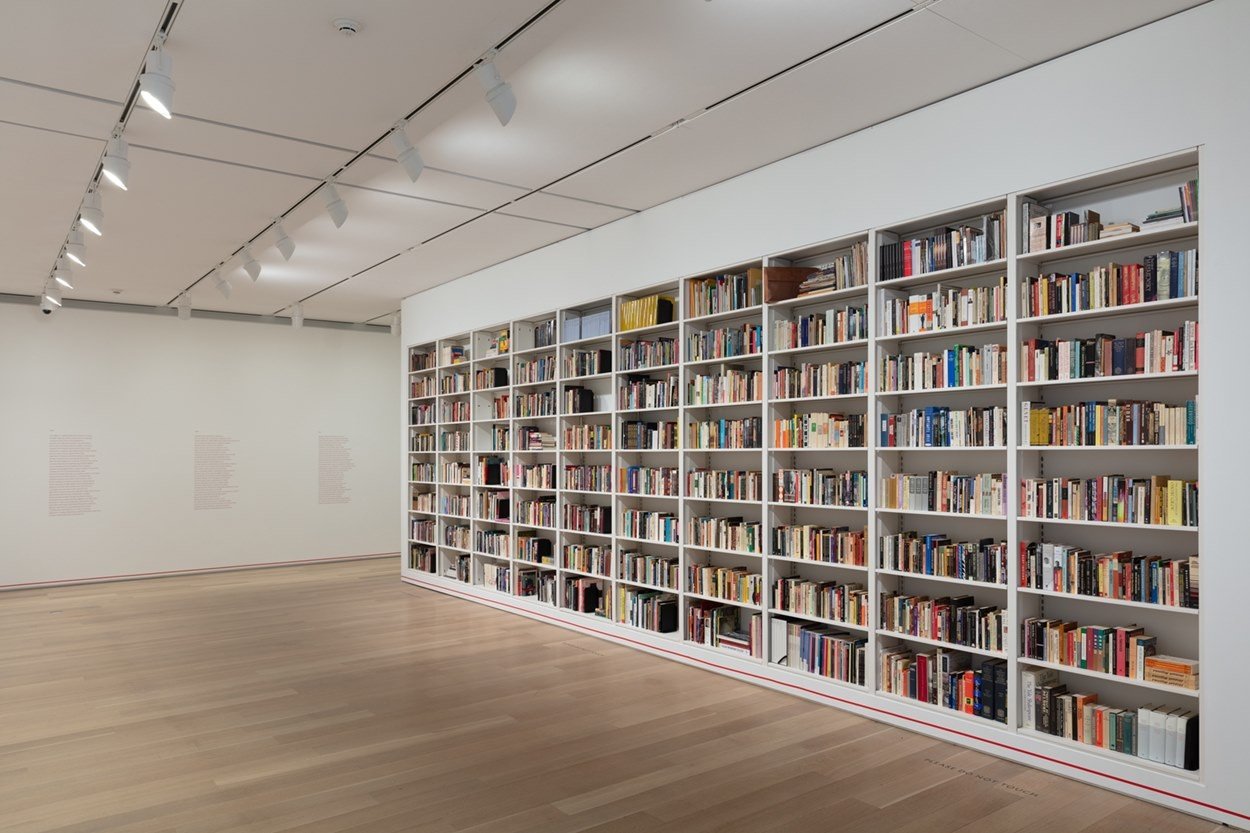
Used with permission of the artist.
The works of Gonzalez-Torres and Bordowitz reveal complex tensions between a personal struggle and a global crisis and pose ethical questions about touch, life and death, privilege, and marginalization. Yet, they also elicit a sense of gratitude and hope for the possibility of building a better future, either by restoring a pile of candy or by sharing one’s library with others—or by restoring a pile of paper.
Figure 6. “Untitled” (Passport), 1991, by Felix Gonzalez-Torres. Installation view: Box of Angels. 500 Capp Street Foundation, San Francisco, California, May 12 to June 29, 2017. Curator: Bob Linder. Photographer: Johnna Arnold. Image courtesy of 500 Capp Street Foundation.
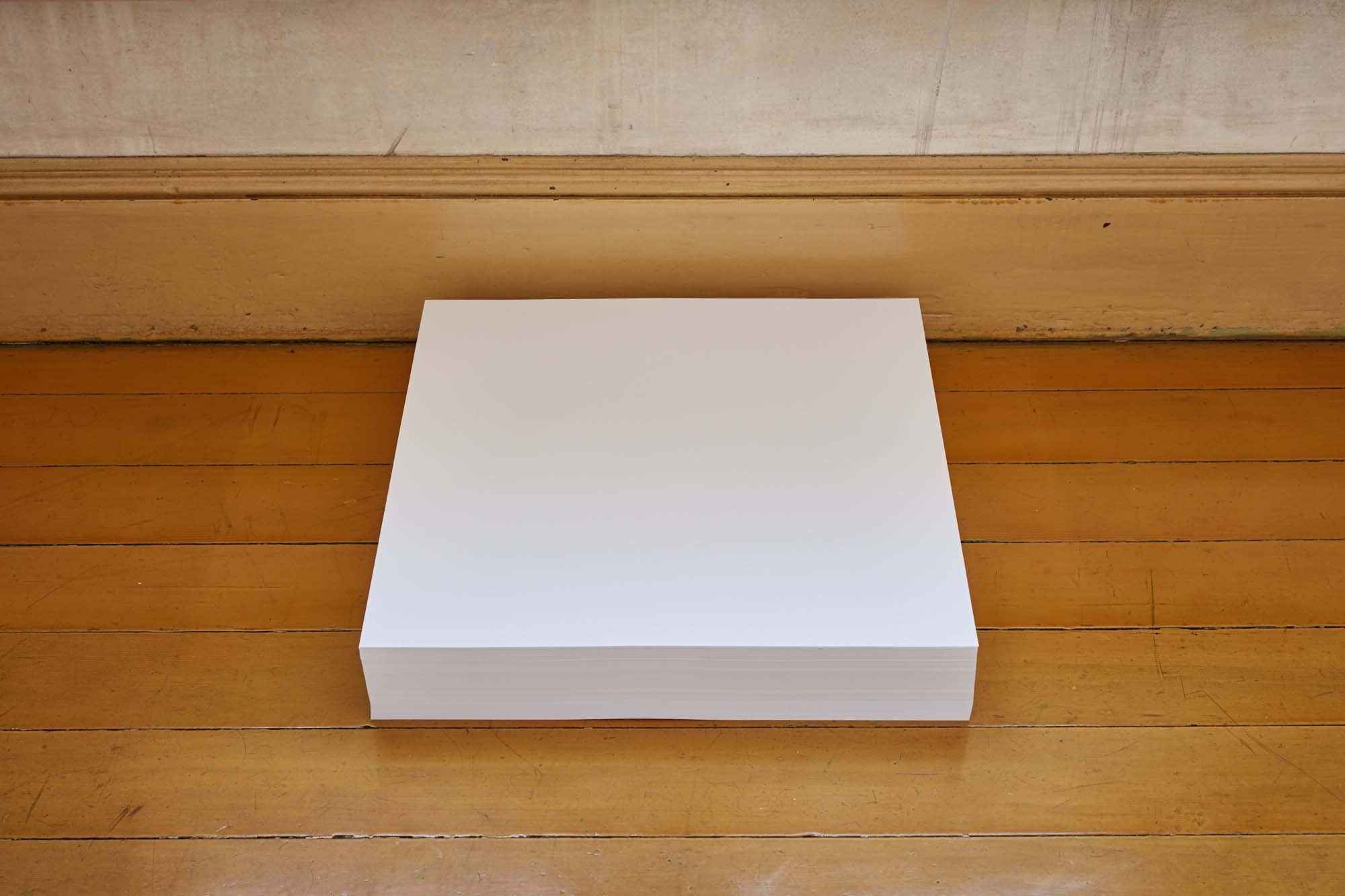
© Felix Gonzalez-Torres. Courtesy of the Felix Gonzalez-Torres Foundation.
Media
Paper, endless supply. 10 cm at ideal height x 60 cm x 60 cm (original paper size)
[4 inches at ideal height x 23 5/8 x 23 5/8 inches (original paper size)].
Gonzalez-Torres wrote a letter to art dealer Andrea Rosen in 1992 in which he described one of his “stack works.” Gonzalez-Torres designed stacks of paper comprised of printed sheets that bear photographic images or oblique texts; individual sheets could be removed by viewers as well as replenished by presenters, respectively. Specifically, with reference to “Untitled” (Passport), he suggested that we might be able to go back to art as “a chance to alter one’s life and future, an empty passport for life… A simple white object against a white wall, waiting.”8
References
-
Bordowitz G. The AIDS Crisis Is Ridiculous and Other Writings: 1986-2003. Cambridge, MA: MIT Press; 2004.
-
Arjini N. Science will not come on a white horse with a solution. Nation. April 6, 2020. https://www.thenation.com/article/society/sheila-jasanoff-interview-coronavirus/. Accessed June 22, 2020.
-
Wojton MA. Love and Loss: The Works of Felix Gonzalez-Torres, the Aids Epidemic, and Postmodern Art [master’s thesis]. Kent, OH: Kent State University; 2010. https://etd.ohiolink.edu/!etd.send_file?accession=kent1277860830&disposition=inline. Accessed June 22, 2020.
-
National Institute of Allergy and Infectious Diseases, National Institutes of Health. Antiretroviral drug discovery and development. https://www.niaid.nih.gov/diseases-conditions/antiretroviral-drug-development. Reviewed November 26, 2018. Accessed July 27, 2020.
-
Bordowitz G. I wanna be well [lecture]. School of the Art Institute of Chicago. https://www.saic.edu/events/gregg-bordowitz. Published April 29, 2020. Accessed June 22, 2020.
-
Douglas F. Cooley Memorial Art Gallery, Reed College. Gregg Bordowitz: I Wanna Be Well, Art Institute of Chicago, April 4-July 14, 2019. https://rdc.reed.edu/c/cooley/s?s=8b01a68e85b7e024f81de36010249a87186daac9&p=1&pp=20. Accessed July 28, 2020.
-
Gregg Bordowitz: I Wanna Be Well [press release]. Chicago, IL: Art Institute of Chicago; March 12, 2019. https://www.artic.edu/press/press-releases/267/gregg-bordowitz-i-wanna-be-well. Accessed June 22, 2020.
-
Miller MH. A colossal new show revisits a conceptual art icon. New York Times. May 11, 2017. https://www.nytimes.com/2017/05/11/t-magazine/art/felix-gonzalez-torres-zwirner-new-york-show.html. Accessed June 22, 2020.



